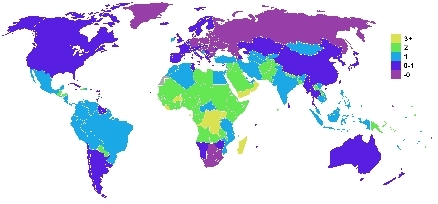Population growth rate
Contents
Introduction
The population growth rate measures how populations (Population growth rate) change in size over time. The units of population growth rate are individuals per time. Population size can only be changed by four factors. Births add new individuals to a population whereas deaths remove individuals from a population. Similarly, immigration into a population adds new individuals whereas emigration out of a population removes individuals. Population growth rates are positive when more individuals are added to a population than are removed, negative when more individuals are removed than are added, and are equal to zero when an equal number of individuals are added and removed. This population size is known as the carrying capacity and is the size beyond which no significant increase can occur due to limitations of some type, e.g., food, water, sunlight, space.
Effects of birth and death rates on population growth rate
Although immigration and emigration can be important factors influencing patterns of population growth in some human populations (for example in the United States), for simplicity, most population growth models focus on how population growth rates are affected by birth and death rates. In population ecology, the population growth rate (dN/dt, units - individuals/time) is the product of the population size (N, units - individuals) and the per capita growth rate (r, units - individuals/time individual). The per capita growth rate, which can be calculated by subtracting the per capita death rate (d – the number of deaths/time/individual) from the per capita birth rate (b- the number of births/time/individual), is a variable that integrates the effects of birth and death rates. See Population growth rate example.
Models of population growth
Population ecologists and wildlife managers have developed models of population growth. Some models of population growth (e.g., exponential growth and logistic growth) make simple assumptions and have helped ecologists to .explore the factors that affect population growth. Other models have been developed to explicitly model population dynamics of particular species in a particular environment.
Further reading
- Campbell, N.A., J.B. Reece, and L.G. Mitchhell. 2006. Biology. Addison Wesley Longman, Inc. Menlo Park, CA. ISBN: 080537146X
- Raven, P.H., G.B. Johnson, J.B. Losos, K.A. Mason, and S.R. Singer. 2008. Biology, 8th edition. McGraw Hill, New York, NY. ISBN: 0073227390
